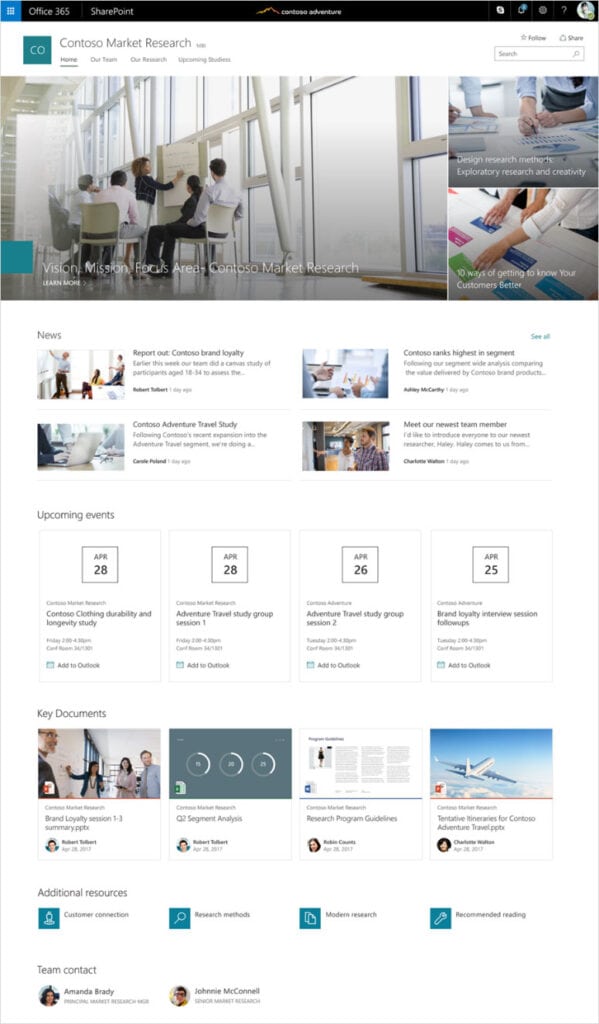Do you need an Intranet?
For many smaller and medium sized businesses, Microsoft Teams fulfills a wide variety of needs. It acts as a hub by centralising content and activity, it has calendaring and meetings, chat and video conferencing and can serve as the main data store for documents, files and media.
As I discussed in a previous blog Using Microsoft Teams for Strategic Employee Communications, Teams has strong communication features that meet a wide range of SMB internal comms use cases.
One of the questions that comes from this is whether Teams can fully replace the need for SharePoint as the company Intranet. Or, put another way, does using Teams mean an Intranet is simply obsolete? Can everything always be loaded into Teams?
Looking under the bonnet
One way of exploring this question, is to lift the bonnet and look inside. Nowadays, like OneDrive, Teams is largely built on SharePoint, with the additional capability of all the Skype-type real-time communications tools – video and voice.
Teams is structured to hold files in channels, which can also be accessed via the SharePoint entry point, and it’s here that SharePoint’s ‘hidden’ infrastructure is revealed. SharePoint is managing files for Teams and, if extra functionality such as tagging, retention and security settings are needed, SharePoint can manage this too. (In future releases, I expect everything to be doable via the Teams interface.)
Burying and Surfacing content
So there we have it, the question seems answered. As Teams is already built from SharePoint, and can manage all the files and content, there’s no need to bother building out a separate SharePoint site to act as a company intranet.
But, as we shall see, the big caveat here is company size and complexity. For less complex companies, just using Teams as a standalone platform can work well.
The rub here though is what I like to call ‘burying and surfacing content’. There’s an old joke that ‘SharePoint is where information goes to die’. Many of us who have worked with large SharePoint sites know only too well the pain of large farms of data where seemingly endless folders host an apparently infinite number of files.
Navigating Teams
Teams, however, can easily create the same information architecture nightmare. Without a level of governance, Teams can proliferate, with content hidden away in numerous channels and their various file folders. Furthermore, while good governance, housekeeping, tagging and file taxonomy can help manage sprawl and scattered documents, Teams can still be difficult to navigate.
It’s not (yet) that graphical and the interface can still not be customised to the degree that many of us would like. If there’s a strong need to surface visual content and news, it can be tricky to do this just in Teams.
An alternate dual-pronged approach
While Teams can act as the de facto standalone internal comms channel, especially for SMBs, it might be easier for more complex companies to support this with a dual-pronged approach.
In this model, Teams sits alongside a lean, focused SharePoint site. You keep Teams for project collaboration work and use something else for storing content that people need to access on a regular basis, and for posting news and updates. That something else is a company intranet powered by SharePoint.
Team site vs Communications site
Unless a company wants the overhead of managing an entirely separate content management system (CMS), there are two choices here: either create and build a SharePoint team site (not to be confused with Teams the app), or make a SharePoint communications site. Microsoft provide a handy overview of when to use which:
Use a team site when you want to collaborate with other members of your team or with others on a specific project. With a team site, typically all or most members can contribute content to the site and the information is limited to only the members of the team or project and specific stakeholders. If your intention is to simply broadcast information out to a broad audience, a communication site is the better choice. With a communication site, typically only a small set of members contribute content that is consumed by a much larger audience.
Create a team site in SharePoint
Where the Communication site wins
The route I prefer, in the use case we’re looking at here, is to build out a SharePoint communication site.
There are compelling reasons for this. The number one reason for choosing a communications site is that it’s easy to quickly create a visually compelling, attractive and functional intranet.
With the communications option, you don’t need high-level SharePoint skills to build it out. Better still, it provides masses of functionality out of the box, so there’s no need to spend ages building out the site, as you would with a team site.
It’s also easy to maintain and update – this makes it an appealing option for someone in, say, comms or HR who hasn’t got in-depth developer skills. A comms person with competent IT skills, can rapidly get up to speed with a communications site and wll be able to post news, graphics and content without having to rely on the IT department to do it for them.
Keep it Simple
As this screenshot from Microsoft shows, you have the audience headline and secondary news, events, documents and content.

What this means is that a comms person can readily surface important updates, news and content and, provided they resist the temptation to overload it, things won’t get buried in the site.
The secret here is simplicity. Keep the News and Events fresh and relevant and use the Key Documents for easy access to the information all people need to do their job, such as training, HR policies and security updates.
Risks to avoid
One final tip – there’s a couple of risks to avoid when running SharePoint alongside Teams.
One is duplicated content and news. Make sure you have a policy on where things are stored and what news goes where. If documents are made by collaborating in Teams, move them over to SharePoint once completed. If you’ve already created a Central Files store in Teams, either move it to SharePoint, or point SharePoint to the Teams store. Put the Teams files in an archive if needed, but don’t maintain two sets of documents.
Similarly, with your comms you should define a model that stipulates ‘what news goes where’. Avoid duplicating news in Teams and SharePoint by creating a simple comms process and sticking to it.
The second risk is that the communications site and the Teams application become separated. To avoid this happening, cross-link between them. At Resonate, we have a ‘Help Centre’ side bar button that takes you directly to our SharePoint intranet.

Another approach would be to create a Teams Channel and load the entire site into a Teams tab. Many companies use a simple website link in a tab and just add the main URL. Others provide navigation to different areas with a series of tabs. Decide what works best for you and simply go with that.
Resonate – here to help!
While a ‘Teams only’ model can work for smaller companies, creating a simple communications site alongside Teams can be a great way of managing content and news in larger organisations.
As we’ve seen, out of the box it can do a lot. This might be enough, but if you have more complex use cases or want to extend functionality by, say, embedding Yammer into the site, then there’s a lot more that can be done.
If you have ideas on how you’d like to build out a SharePoint site, or even if you just need help setting one up or creating basic governance, please get in touch with our experts. At Resonate, we are always here to help.




